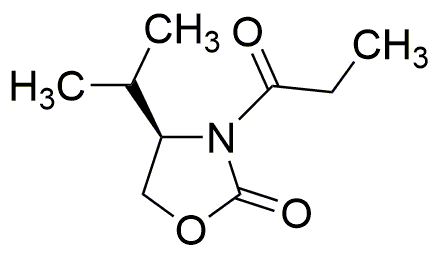(R)-(-)-4-Isopropyl-3-propionyl-2-oxazolidinone is widely utilized in research focused on:
- Pharmaceutical Development: This compound serves as an important intermediate in the synthesis of various pharmaceuticals, particularly in the development of drugs targeting neurological disorders.
- Chiral Catalysis: Its unique chiral properties make it valuable in asymmetric synthesis, allowing chemists to create specific enantiomers that are crucial for the efficacy of many drugs.
- Food Industry: It can be used as a flavoring agent or additive, enhancing the sensory profile of food products while maintaining safety and regulatory compliance.
- Cosmetic Formulations: The compound is incorporated into cosmetic products for its stabilizing properties, helping to improve the texture and longevity of creams and lotions.
- Research Applications: In academic and industrial laboratories, it is employed in various chemical reactions and studies, particularly in exploring new synthetic pathways and reaction mechanisms.
General Information
Properties
Safety and Regulations
Applications
(R)-(-)-4-Isopropyl-3-propionyl-2-oxazolidinone is widely utilized in research focused on:
- Pharmaceutical Development: This compound serves as an important intermediate in the synthesis of various pharmaceuticals, particularly in the development of drugs targeting neurological disorders.
- Chiral Catalysis: Its unique chiral properties make it valuable in asymmetric synthesis, allowing chemists to create specific enantiomers that are crucial for the efficacy of many drugs.
- Food Industry: It can be used as a flavoring agent or additive, enhancing the sensory profile of food products while maintaining safety and regulatory compliance.
- Cosmetic Formulations: The compound is incorporated into cosmetic products for its stabilizing properties, helping to improve the texture and longevity of creams and lotions.
- Research Applications: In academic and industrial laboratories, it is employed in various chemical reactions and studies, particularly in exploring new synthetic pathways and reaction mechanisms.
Documents
Safety Data Sheets (SDS)
The SDS provides comprehensive safety information on handling, storage, and disposal of the product.
Product Specification (PS)
The PS provides a comprehensive breakdown of the product’s properties, including chemical composition, physical state, purity, and storage requirements. It also details acceptable quality ranges and the product's intended applications.
Certificates of Analysis (COA)
Search for Certificates of Analysis (COA) by entering the products Lot Number. Lot and Batch Numbers can be found on a product’s label following the words ‘Lot’ or ‘Batch’.
*Catalog Number
*Lot Number
Certificates Of Origin (COO)
This COO confirms the country where the product was manufactured, and also details the materials and components used in it and whether it is derived from natural, synthetic, or other specific sources. This certificate may be required for customs, trade, and regulatory compliance.
*Catalog Number
*Lot Number
Safety Data Sheets (SDS)
The SDS provides comprehensive safety information on handling, storage, and disposal of the product.
DownloadProduct Specification (PS)
The PS provides a comprehensive breakdown of the product’s properties, including chemical composition, physical state, purity, and storage requirements. It also details acceptable quality ranges and the product's intended applications.
DownloadCertificates of Analysis (COA)
Search for Certificates of Analysis (COA) by entering the products Lot Number. Lot and Batch Numbers can be found on a product’s label following the words ‘Lot’ or ‘Batch’.
*Catalog Number
*Lot Number
Certificates Of Origin (COO)
This COO confirms the country where the product was manufactured, and also details the materials and components used in it and whether it is derived from natural, synthetic, or other specific sources. This certificate may be required for customs, trade, and regulatory compliance.


